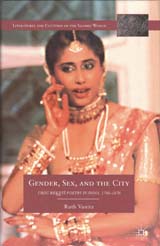-
The author Ruth Vanita is probably one of the most well known scholars in the field of Indian Queer studies. This book is based on almost ten years of research, which started with the publication of her first collection, Same Sex Love in India (2000).[1] This work fills a lacuna in our knowledge about rekhti poetry which has traditionally been deemed to have little literary merit and had almost disappeared until a revival in its scholarship in recent years. This is a superb piece of solid academic output, meticulously researched and well written in an easily accessible language.
-
The author uses a variety of approaches ranging from critical theory, textual analysis, postcolonial and feminist theories to study this rich body of literary production. For the uninitiated, Rekhti poetry is a type of Urdu poetry 'whose distinguishing features are a female speaker and a focus on women's lives' (p. 1). These were written mostly by men in begumati zaban (language of the women). However one must remember that women's language was not spoken by women alone but by non elites as well and was adopted by poets to represent an indigenous urbanity.[2] Vanita points out that critics assume that rekhti poetry was never intended for women as they were written by men, and women hardly ever attended public gatherings and therefore there was an element of voyeuristic pleasure in this work. Vanita however challenges this assumption and points out that whilst women in 'conventional households' might not have attended public gatherings, courtesans who were highly educated, reading both Urdu and Persian did attend these gatherings and many were poets themselves.
-
In the first half of the book, Vanita examines the urban spaces occupied by women and their 'agency as consumers of fashion, clothing and food in the city' (p. 41). Domestic and non secluded spaces such as orchards and gardens and rooftops become areas of privacy and enticement. The author portrays the network of aesthetic features within rekhti poetry which depict seemingly mundane things like shopping, cosmetics and jewellery and uses them to map out a female geography. In the next chapter, Vanita studies the language structure in rekhti and its relation to gender. She states that the language of rekhti, which was colloquial Urdu, emerged as a literary rival to both Persian and the Persianised Urdu. This 'everyday language' was not just a language of domesticity but one used by courtesans and prostitutes in the marketplaces and streets. Thus class becomes an important factor as this type of poetry came to be associated with low class leading to its later disappearance.
-
Another important feature of rekhti was the insight it gave in to women's domestic lives, painting a lively picture of the city where 'servants, slaves and subordinates constitute its rainbow spectrum' (p. 97). In mainstream poetry, servants are rarely spoken to or spoken about but in this poetry their voices are heard as well. While in some poems, Vanita brings out the harshness in the relationship between the speaker and the servant, such as the following piece by the poet Rangin:
Why do you keep muttering and scowling all the time
May destruction fall on you bandi (p. 98).
-
In other pieces, Vanita picks on the ambiguous intimacy that exists between the speaker and the servant, where they perform the role of the friend, acting as a messenger for the speaker or a confidante to whom the speaker confides her troubles. The relationship is often reciprocal and the subordinate who is familiar with her mistress's past sometimes talks about it, like Insha's piece shows:
Oh bari-dai don't touch on those past matters
Why do you scratch the scabs of my heart's wounds (p. 101).
-
Throughout, this book we come across a fascinating array of poets that shaped the development of this genre of poetry. These include, Nisbat, Rangin, Inshah, Jan Sahib and others. Vignettes of their work deftly translated by the author add complexity and texture to the critical analysis and theoretical discussion in the book. The author has also signposted the reader to original collections and manuscripts where these poems maybe found. This is a wonderful book, where every chapter opens up new possibilities for research. This study can be understood in a variety of ways but there is little doubt that they constitute a gradual dismantling of the 'singular' Urdu ghazal, which as the author points out, 'for most people today is synonymous with Urdu poetry' (p. 1).
-
In conclusion, this book is a significant contribution for those engaged in the study of South Asia and Islamicate cultures, as well as those interested in gender and sexuality. Vanita's work has already suggested new directions for research in this field. I predict this will remain a key text in the area for many years to come.
Endnotes
[1] Ruth Vanita and Saleem Kidwai (eds), Same Sex Love in India: Readings from Literature and History, London: Palgrave Macmillan, 2000.
[2] Ruth Vanita, 'Married among their companions: female homoerotic relations in nineteenth century Urdu Rekhti poetry in India,' in Journal of Women's History, vol. 16, no. 1 (2004):12–53.
|



